The Mary D. Hume
Today, history put aside. The University of Houston's College of Engineering presents this series about the machines that make our civilization run, and the people whose ingenuity created them.
As the Rogue River leaves southern Oregon, it passes under a lovely nineteen-hundred-foot art deco bridge, built in 1941 for highway 101. Then it flows between jetties into the Pacific.
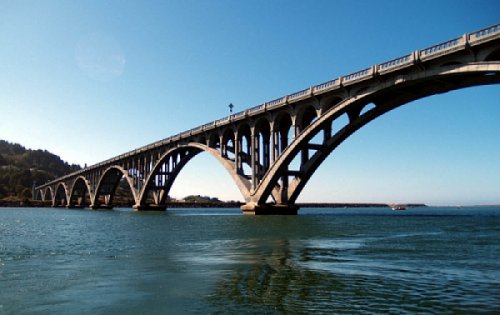
The north jetty is mostly gravel -- except for a small rescue facility for feral cats. People put out food by a row of miniature houses for strays. (The cats compete with seagulls for the food.) The south jetty has a large sheltered dock, home to fishing boats and Rogue River jet boats. (Returning fishermen compete with basking sea lions as they transfer their fish to shore.)
Driving onto the south jetty, one hardly notices a half-sunken boat, wallowing near the jetty. One sees a lot of castoff wood and iron in this far corner of the world. The living seas and forests quickly consume such remains with rust and decay.
But this wreck has a story to tell: It began right here in 1876 when R. D. Hume moved his salmon industry down from Astoria. His small supply steamer sank on the Rogue River four years later. So Hume salvaged the engine and other parts. He found a huge spruce tree from which he could build the keel in one piece. In January, 1881, he launched this new boat, a solid 98-foot, all purpose steamer. He named it the Mary D. Hume after his wife.
The Mary D. Hume hauled goods between the Rogue River and San Francisco for ten years. Then an Alaska whaling company bought her and put her to work as a whaling vessel. She made a pile of money for her company in that fearfully harsh service; but too many sailors died during her long voyages in terrible conditions.
When the whaling boom died out, she continued in service as tugboat, a tender for halibut fishing boats, and a towboat. Her steam engine was exchanged for Diesel power in 1954, and she kept working until 1978. Then, after the longest Pacific coastal service of any boat, she motored back to these jetties and was given to the Curry County Historical Society. Crowds cheered as she came in. She was entered on the National Register of Historical places.
Then it all went bad. It took seven years to rig a sling. When they tried to lift her out for repairs the sling broke. Then its structure failed. The boat fell and sank in four feet of water. Now less of her remains each year: boards crumble, metal rusts. We notice a lone gull perched on the remains of her smokestack. When I search the Internet for Mary D. Hume I find mostly photos and paintings of her for sale. Her long slow death makes fine grist for artists. I guess they see our own aging in this old hulk.
The creatures across the river are doing a lot better. So we cross over to visit those little cat dwellings. And we find a very different scene. Only two feral cats today -- two cats and a blizzard of gulls swooping past our ears. The place rings with a joyful cacophony of life. After twenty minutes of this, we can leave these jetties feeling much better about the fate of the Mary D. Hume-- and about the world in general, as well.
I'm John Lienhard, at the University of Houston, where we're interested in the way inventive minds work.
In the text above, I don't name the town where all this is to be found. It's Gold Beach, Oregon. It lies near the extreme southwest corner of the state. All photos by John and Carol Lienhard on August 19, 2007, except for the two linked aerial photos. They are courtesy of Google Earth.
For more on the Mary D. Hume, click here.
For more about the Rogue River Jet boats, see: http://www.roguejets.com/ or: http://www.mailboat.com/
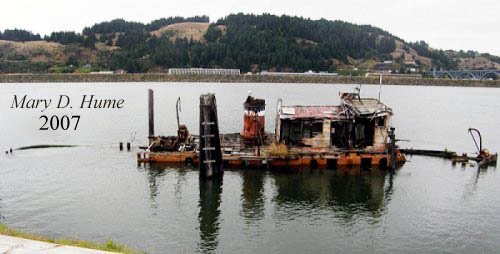
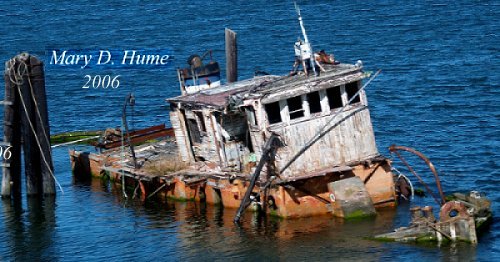
What a difference a year makes.
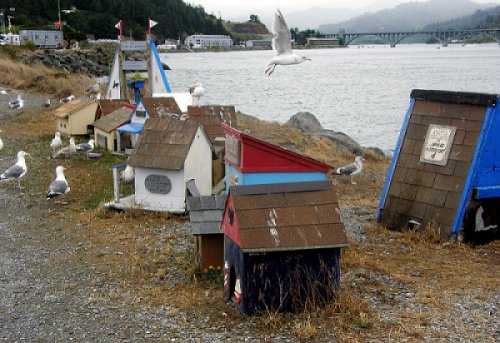
The so-called Feral Kitty City on the north jetty
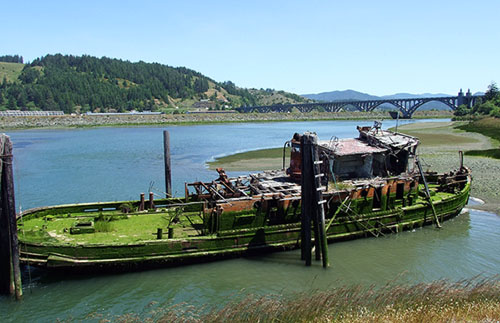
This remarkable picture was taken by Rod Shanks at low tide in the Rogue River estuary during the dry month of June 2006. It reveals the seldom-exposed lower portion of the ship. For a large version of this image Click Here.